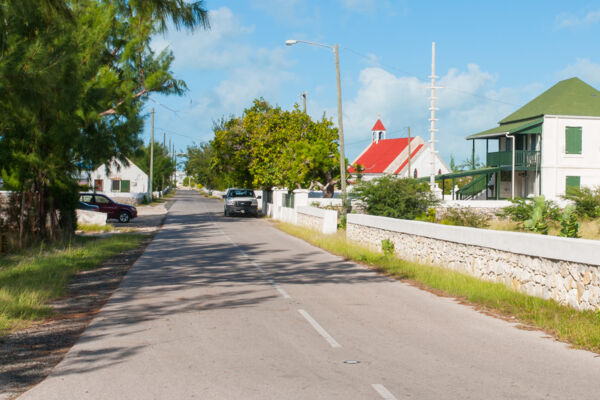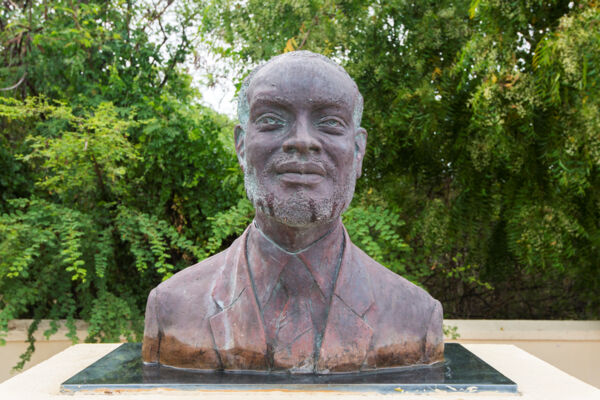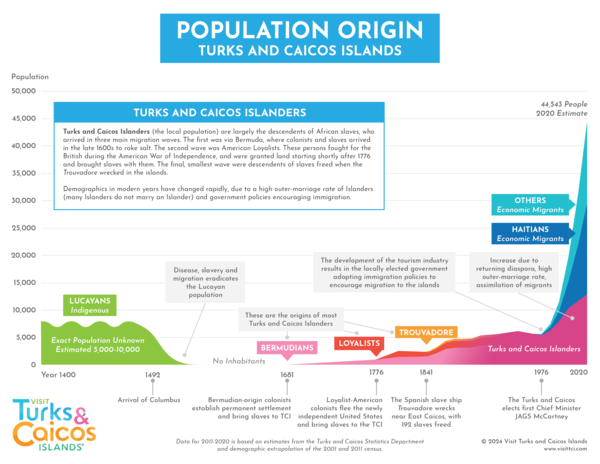Turks and Caicos Population

The population of the Turks and Caicos is 47,720, according to the 2022 estimate by the Department of Statistics. The last census was in 2012, which at the time reported a population of 31,458 persons. Previous censuses were held in 2001 and 1990.
The growth in population is not spread evenly throughout the country. Providenciales continues to see the overwhelming majority of population growth, with Grand Turk (home to the capital of Cockburn Town) experiencing modest gains in population. Most other islands in the archipelago have seen little change in the population since the mid-1990s.
National Population
The last census was held in 2012. Preliminary data was published, but the final report was never published.
Data below is compiled from a variety of sources, including archive records and national censuses. Data from 2012 onwards are estimates from the Department of Statistics and ECLAC.
Turks and Caicos Population
| Turks and Caicos Population by Year | |
| Year | Population |
| 1781 | 921 |
| 1829 | 2046 |
| 1842 | 2495 |
| 1851 | 3250 |
| 1861 | 4372 |
| 1871 | 4723 |
| 1881 | 4732 |
| 1891 | 4785 |
| 1901 | 5287 |
| 1911 | 5616 |
| 1921 | 5612 |
| 1943 | 6138 |
| 1960 | 5668 |
| 1970 | 5558 |
| 1980 | 7413 |
| 1990 | 11465 |
| 2001 | 19886 |
| 2012 | 32458 |
| 2020 | 44543 (estimate) |
| 2022 | 47677 (estimate) |
Population by Island

Six major islands and three cays are inhabited: Providenciales, North Caicos, Middle Caicos, South Caicos, Grand Turk, Salt Cay, and Pine Cay, Parrot Cay, and Ambergris Cay.
Grand Turk, Salt Cay, and South Caicos were the ‘salt islands’, which was the first industry in the country. Later on, plantations were developed on the Caicos Islands of North Caicos, Middle Caicos, Providenciales, and West Caicos.
The salt industry ended in the early 1940s, and the years afterward saw large-scale migration from the islands, mostly to neighboring Bahamas (particularly Grand Bahama).
The mid 1980s saw the construction of Club Med, which started the tourism boom of the 1990s and early 2000s. Along with increased international tourism came large-scale migration to meet the demand for service workers. This rapidly began to change the demographics of the islands.
Migration and Demographics
Haitians make up the overwhelming majority of migrants. Citizens of Haiti accounted for 34.7% of all residents in 2012 (compared to 38.9% Turks and Caicos Citizens). It is projected that Haitian nationals have become the largest demographic group in the Turks and Caicos. Citizens of other Caribbean countries make up the majority of the remaining migrants.
The other main demographic groups, as noted in the 2012 Census, by country were:
- Dominican Republic - 4.9%
- United States - 2.8%
- Bahamas - 1.8%
- Canada - 1.3%
- United Kingdom - 1.2%

Population by Island
| Population by Island | ||||||
| Year | Providenciales | North Caicos | Middle Caicos | South Caicos | Grand Turk | Salt Cay |
| 1960 | 518 | 1150 | 532 | 840 | 2180 | 438 |
| 1970 | 558 | 999 | 362 | 1018 | 2287 | 334 |
| 1980 | 977 | 1278 | 396 | 1380 | 3098 | 284 |
| 1990 | 4821 | 1275 | 272 | 1198 | 3691 | 208 |
| 2001 | 13021 | 1347 | 301 | 1063 | 3976 | 120 |
| 2012 | 23769 | 1312 | 168 | 1139 | 4831 | 108 |
Belongers - Turks and Caicos Islanders
Belongership was renamed Turks and Caicos Islander Status.
The Turks and Caicos is not a sovereign country, instead being a British Overseas Territory. British Overseas Territory Citizenship (BOTC) is issued by the United Kingdom, and the majority of Belongers are BOTCs, which is the citizenship of their passport.
However, being a BOTC doesn’t grant rights normally associated with citizenship, such as voting and the right to hold political office. The local government grants Turks and Caicos Islander Status (previously titled Belongership), which grants the rights normally associated with citizenship.
The data below is from the census and estimates from the Department of Statistics, UN, and ECLAC. For the census, individuals self-reported their status, and it is commonly accepted that some persons, such as those born in the country, state that they hold Belongership, when they only hold citizenship.
Belonger vs Non-Belonger Population Share
Turks and Caicos Population Policies
Successive local government administrations have either initiated or proposed a population policy, most recently in 2019 when a Trinidadian consulting company was hired to produce a report and policy.
Various policies have been put in place with the goal of reducing the need for migrant workers and encouraging the hiring and empowerment of Belongers. However, the lack of serious investment by Government administrations over the years hinders this goal.
